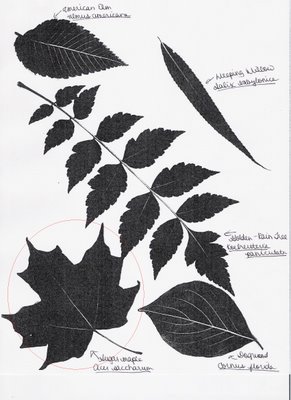Part of the process includes using a dichotomous key. Any takers as to what that is?! Instead of making you wait in anticipation for another post, I'll just fill you in now. A dichotomous key is a written device used by scientists to identify organisms and objects. "Dichotomous" refers to the fact that there are two lines or phrases identifying a trait of the organism. The purpose is to describe the organism or object in a series of steps to narrow down the possibilities of what it is. In Botany, this is done by separating out different kinds of plants into groups and eliminating the erroneous possibilities. For example, a typical dichotomous key could start out like this:
1a. Leaves deciduous (fall out in winter) - step 2
1b. Leaves not deciduous (evergreens) - step 20
In this instance, you are eliminating several steps just in the first lines. The purpose is to follow the steps until you know with a great level of certainty what a specific plant (in this case, tree) is. We practiced this around campus, and used the key with great success. Of course, when it comes down to different trees in the same family (oaks, for example), it becomes more difficult to differentiate due to cross-breeding or similarities in tree features. But, this key would be useful in determining the family or genus of a particular tree.
Next, my professor gave us a mini-assignment of our own. After using a key she provided, she gave us the opportunity to create our own key. She gave each person a unique print-off that had images of leaves from around the campus. Each person had five leaves on their paper, and had to create a key for those particular leaves. I have scanned the paper I received into this post. Can you find anything in that image that might explain the title of this post?
 (Hint: Look in the lower left-hand corner.)
(Hint: Look in the lower left-hand corner.)
Do you see it? For those who could not, it is a Sugar Maple leaf, the leaf on the Canadian flag! Being of French-Canadian ancestry, as I am, and as many of you readers are, it was very fitting for me to get the Sugar Maple leaf for my project, the symbol many Americans associate primarily with Canada. Wouldn't my Beauregard ancestors be proud?
So, my task by Thursday is to create a dichotomous key for these five leaves. I can take any approach I wish, but the recommendation of my professor was to separate the leaves into simple and compound leaves. Simple would be, for example, the Sugar Maple leaf. Compound, for example, would be the long branch with several leaflets in the middle of the page (the Golden-Rain Tree). By differentiating between simple and compound, I would be able to eliminate one of the leaves from my possibilities, since there is only one compound leaf. This would also allow me to not differentiate between mundane characteristics like leaf margin or apex shape, which would be harder to differential than the difference between simple and compound. Do you get the idea?
Well, that's the end of my lesson tonight. I hope I didn't utterly confuse everyone in the process! Oh, and by the way, to answer the question posed by my grandfather on my last post, yes, I do know what that is. I believe you mean "apical meristem," and that is the tip of a leaf, root, or stem where the plant continues to grow. Anyways, that's it from me! I hope everyone is having a good week, and had an enjoyable, long Labor Day weekend.

7 comments:
A while back I bought a book that has a lot of this information, but more specific to just identifying trees (well, I AM TREEbeau, you know). Anyway, I recall terms like "pinnate" and veins or leaflets that are opposite or alternate.
Does anyone else see "Jack and Jacques" in the maple leaf?
And your African-American ancestor, Luther Burbank, would be proud of you too. :-)
We are indeed proud of you, with or without the maple leaf.
Related to Luther Burbank?
That's a big name out this way.
By the way, I researched it and Luther Burbank was not black. Just an error in Uncle Tim's information...
And you might recognize his name for potatoes, not for the city of Burbank in CA as apparently he is mistaken for.
Like Sean said, Uncle Tim made a mistake. I intended "George Washington Carver" but the name "Luther" stuck out in my head as sounding African American. SO I confused the two.
My apologies to Luther and George.
I believe he is the namesake for Luther Burbank Middle and High Schools out here.
You are correct with apical meristem. Is it in your text or did you require a trip to the library?
Post a Comment